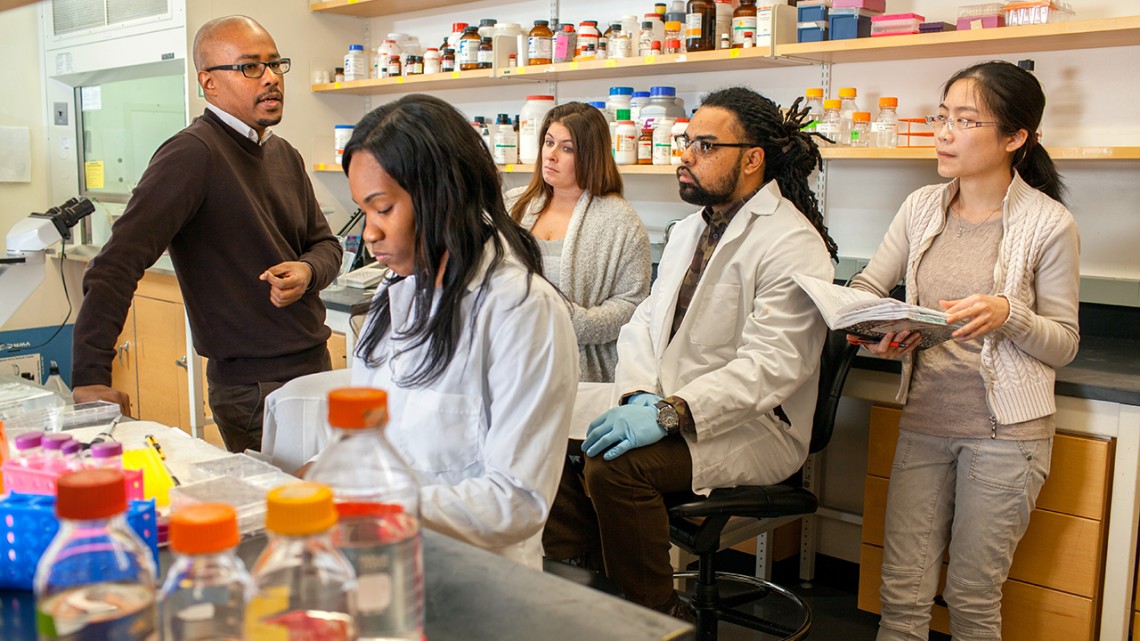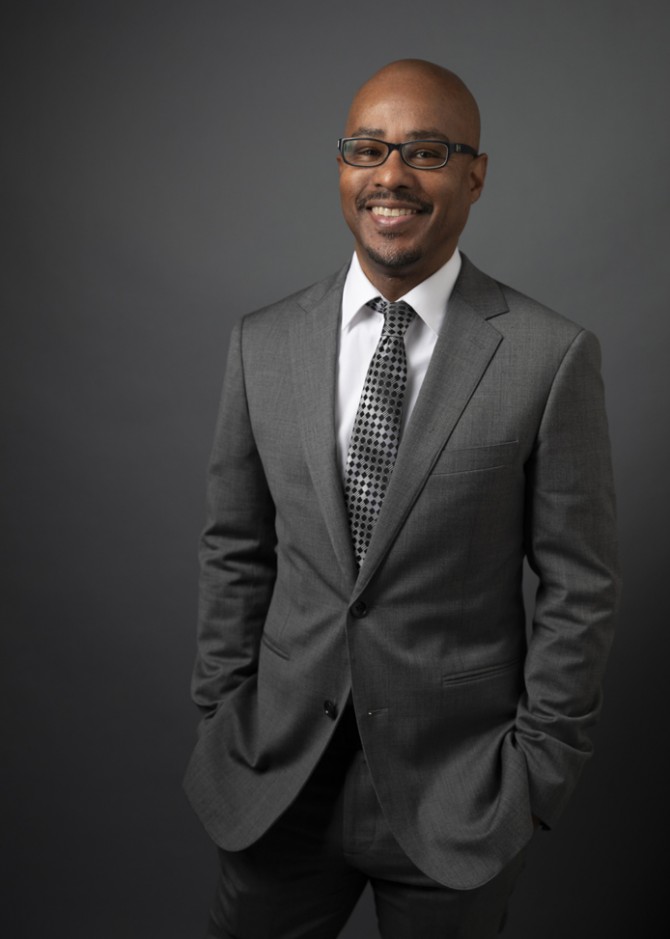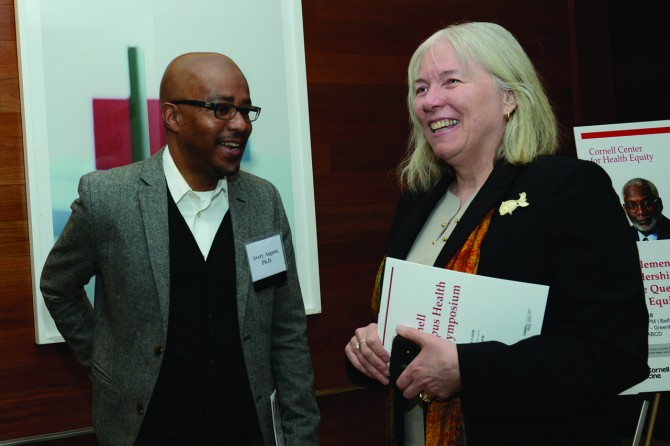
Avery August, Ph.D. ’94, in his immunology lab with members of his research team.
Avery August is building a pipeline for faculty diversity
By Joe Wilensky
Avery August, Ph.D. ’94, is a professor of immunology in the College of Veterinary Medicine, the university’s vice provost for academic affairs and co-director of the Cornell Center for Health Equity, which spans the Ithaca campus and Weill Cornell Medicine. Last year, in recognition of his research and in helping Cornell transfer students get involved in undergraduate research, he was named a Howard Hughes Medical Institute professor.
How do you manage and balance all your roles at Cornell?
The interesting thing is, all the roles I have involve things that I’m really passionate about. I’m passionate about the research, I’m passionate about education, and I’m really interested in the role that I have now as a vice provost.
I look at all the things I’m doing each day and rebalance them as I go along. The thing that’s the most difficult is to maintain the level of research discussions with the students I have in my lab, and keeping up on the most recent research in my field. Because all the other things come with deadlines and research doesn’t, I’m always trying to make sure that I’m paying attention to that as well.
Tell me about the Cornell Center for Health Equity.
This dual-campus center is partnering with local communities in New York City and upstate New York to understand why health outcomes vary among demographic groups and how to eliminate those differences.
We had a soft rollout and an opening symposium last March at Weill Cornell Medicine in New York City; it included faculty from Ithaca and New York City, including Weill Cornell Medicine and Cornell Tech, and I think it was a great success.
Since then, the center has been expanding. We had our first pilot grant initiative this last year, small seed funds that the center is providing to members to catalyze research collaborations across the campus. We funded two of those pilot grants, one in New York City and the other in Ithaca. One will examine barriers to care for black patients with advanced symptomatic osteoarthritis, and the other, to be carried out in Ithaca, will evaluate a model of care on improving health outcomes for people who inject [illegal] drugs.
The idea is to continue to offer pilot grants with the goal of building a robust, extramurally funded collaborative research center. Another of the missions of the center is to train the next generation of researchers in health equity and to increase the proportion of students going to medical school who are interested in this area.
How do you and Dr. Monika Safford handle co-directing the center?
Dr. Safford is the executive director and co-director for Weill Cornell Medicine, and I largely lead the efforts and initiatives up here in Ithaca.
Monika brings a physician’s perspective and a view of health equity from a social perspective. I’m a basic scientist, and we would like to recruit more individuals who work in the basic sciences to look at their work through the lens of health equity, to work on the biology of health equity that complements the social view of health equity.
The other thing I bring to this position is my work in developing faculty, developing investigators and developing the next round of leadership.
Much of what we’re trying to do is break down some of the structural barriers that exist between the two campuses. We want to reach faculty here in Ithaca and from Weill Cornell Medicine, to encourage collaborations around research and education in the areas of health equity.
How long have you been interested in health equity?
I work on fundamental immunology. My research group tries to understand how the immune system works and how it influences the development of inflammatory diseases. And for many years we have been trying to understand how allergic asthma and lung inflammation develop.
One could look at this work and say, this is not health equity. But I work on a disease that predominantly affects communities of color. So I’ve always been interested in that space. As a lab-based scientist, you come at it from a biology perspective, but you soon realize that much of it has to do with policies, urban communities that are affected, and health care access that leads to exacerbation of disease.
Many students today are interested in working in health equity, and they come at it from many angles and perspectives. But I think the catalyzing feature here is this glaring inequity that you see in health access and health care.
What has changed regarding diversity and how faculty candidates are recruited and hired at Cornell?
One of the things we’re spending a lot of time on – and that we’ve been changing – is, who is applying for faculty positions here? How do we broaden the pool of applicants? We understand that many potential faculty, particularly those of color, may look at Cornell and say, “I won’t even apply.” And so the first place to start is to reach out to those potential faculty and say, “We welcome your applications. We want to cast as wide a net as possible to get the best people here.”
We also want to make sure that departments and search committees understand that as part of their search process, it’s not just a matter of putting an advertisement in a relevant place – it’s about reaching out, using contacts, knowing where those potential faculty graduate from, where they’re doing their training, and to actually encourage them and to invite them to apply.
Even before I was in this position, Cornell began a process to ensure that for each faculty search, someone at the college level would ensure the application pool is diverse, and if the pool isn’t diverse, for the search committee to revisit the process they used to develop that pool.
We have since developed a faculty pipeline tool, to provide all departments with information to assist in searches, such as identifying institutions that are graduating significant numbers of women with Ph.D.s in STEM fields and those that are graduating significant numbers of students of color with Ph.D.s. Departments can then reach out to those institutions as they develop their search, so that they can ensure that potential faculty know about Cornell and that we want them to apply.
That is in addition to what the provost has already done, through bridge funding to colleges to support their efforts in hiring faculty who diversify our ranks. He has since tripled his commitment: from the equivalent of 25 percent salary to 75 percent salary support for five years.
Once we hire, we want to ensure a faculty member arrives in a place where they want to stay. We ask departments to develop a mentoring plan for new faculty – to let us know how they will welcome that person. Different colleges and departments have different approaches to doing that, but we want to make sure that it’s deliberate, that there’s a process in place.
We are calling it pre-emptive retention. It’s ensuring that the faculty member has what they need, and that we are recognizing them for all their work, so that they don’t look elsewhere. If faculty are doing extraordinary mentoring, they should be recognized for that. It’s making sure in multiple ways that people feel that their work is valued here. If we’re able to do that effectively, and another institution calls them, they’ll say, “I’m happy at Cornell – I don’t need to go anywhere else.”
Tell me about your proposal to enhance and promote the research experience for transfer students in the biological sciences?
I was a community college transfer student when I was an undergraduate, and I understand the difficulty students can have coming from a community college to a major research institution. The goal is to enhance their ability to do research here. I’ve had students in my laboratory at Cornell who were community college transfer students; I’ve talked to them about their experiences. It’s a very different culture they transfer into.
We’re still in the startup phase. We started meeting with a small cohort of students who started in the summer. We have a related course, Preparing Future Researchers, that focuses on mentoring, community development, peer interactions and sharing ways of being successful here.
We’re already hearing from the students – and from students who are interested in being part of it – that this is something they’ve really been looking for. There are other parts of their transfer experience that have been taken care of by Cornell, but one of the big gaps is that it’s very difficult for undergraduates transferring here to get access to performing research in biological sciences because so many students want to do it. When they come here, they’re already at a disadvantage finding research experiences compared with students who came here as freshmen, who have had two or three years to find such opportunities.
How has your background prepared you for your multiple roles today?
I haven’t really reflected on this until very recently. I went to community college and was a transfer student; I went to a non-Research I institution, but I also then attended Weill Cornell Graduate School of Medical Sciences. Those experiences led me to develop the program promoting research experiences for transfer students.
I understand the culture and the community at Weill Cornell Medicine; I think that has allowed me to be more effective helping to get the cross-campus center established.
I’m an immigrant; my mother was undocumented when she first came to this country. We have DACA students here, and I can understand how those students feel.
When I look at what I can do as a scientist, working in a community that intersects with health equity and also in training students of color, I am trying to make sure I’m able to mentor and give back – to students of color, to faculty of color – initially as a faculty member, more recently as a chair of microbiology and immunology in the College of Veterinary Medicine, and now as vice provost.
I’m trying to make sure that when we recruit, we do it the right way, we try to diversify our pool. When we get faculty here, we mentor them, we give them the right tools for them to be successful here.
So much of this work keeps coming back to this idea of “increasing the pipeline.” It’s a goal that encompasses undergraduates, graduate students, and faculty recruitment and retention.
As another example, we recently received a grant from the National Institutes of Health to fund the Cornell Initiative to Maximize Student Development. This will provide funding and professional development for students of color across our life sciences graduate programs. This fall we took in our first three students in that program.
Also, operating under the auspices of the Center for Health Equity is a planned Diversity Center of Excellence, with funding that Dr. Safford and Dr. Susana R. Morales at Weill Cornell Medicine received from the U.S. Health Resources and Services Administration. This is another way we are trying to build a pipeline of undergraduates who are interested in medicine and health equity.
Media Contact
Get Cornell news delivered right to your inbox.
Subscribe



